The Nikon L35AF is a bit of a cult classic in certain circles it seems. I’ve written about the Nikon AF3, the 3rd iteration of this camera, but when I was writing about it I couldn’t help wonder if I was missing anything in the first version. Especially as I’d read a number of times that the first one had the better lens. So when the opportunity came up to buy one, I grabbed at it.
I liked the third version quite a lot. It’s a big camera, and not exactly whisper quiet, but it’s simplicity of function was something I really took to, it was cheap too – I think it only cost me a fiver… It seems logical to me that over time a company like Nikon would build on and improve a first version, rather than lessen its quality. So I suppose my biggest concern with going backwards from the 3rd to 1st model would be a loss of refinement, the L35 certainly looks a little more clunky…
The Nikon L35af – Nikon’s first AF compact (is getting old)
Nikon regularly seem to be late to the party. They are yet to release any professional specification small interchangeable lens camera to compete with the likes of the Sony A7 cameras, they were later to the full frame digital camera market compared to Canon, and looking back at this camera they were also later to the autofocus compact camera party. Of course those who were interested in such things will remember that when Nikon eventually released the long awaited D3, there was very little in the way of disappointment. In fact, I think it was probably a little bit of a shock to the system for Canon who seemed to be on the back foot for the few years that followed.
I should point out that although it was released in my lifetime, the Nikon L35af hit the market in 1983, which was actually the year I was born, so funnily enough I don’t remember how the market felt about the camera compared to its rivals in the same way as I remember the digital D3. Reading bits here and there online about the Nikon L35af though, whats clear is that when Nikon launched the it, they took similarly high levels of pride in it, to the extent in fact that they called it ‘Pikaichi’, which apparently means ‘top notch’. I have no idea if this is right, I don’t speak Japanese, but handling and using this ‘Pikaichi’ camera I can tell that one thing is true, Nikon put a lot of effort into making this camera something a little more than its competitors.
Of course, like me, the Nikon L35af turned 33 this year, so the question is, how well has it stood up to the sands of time? There have been a hell of a lot of cameras since the Nikon L35, not least it’s two successors the L35AF2 and AF3. But taking into account other classics such as the mju-ii from Olympus – which is significantly more pocketable and arguably has just as good (though somewhat more clinical) a lens – is there still a place for the Nikon L35 as a useable classic? What makes this camera so much worth the risk when other very similar cameras from the same era can be had for so little? Are people enthralled perhaps by the classic design, the simple function, or purely a matter of the quality of the lens? What is the big attraction to this camera?
Reviewing a broken camera
The first thing I want to point out about the camera I have here is that it’s not actually working all that well. It has an intermittent fault that means sometimes (probably 60% of the time) when you press the shutter button, nothing happens. I thought to start with that this might be down to duff batteries, but after trying two sets of brand new out of the packet AAs, I’m still having the same problem. I happened to mention this on Instagram and someone else responded reporting a similar issue.
So what does all this mean? Well, probably little more than that me and this chap on Instagram have been unlucky. But unfortunately, it’s all drawn my attention to the age and potential functional fragility of these cameras. Me writing this review also comes directly after me writing a post detailing some of the advantages of shooting with early thread mount Leica cameras. In that post I go into some detail about how whilst they might be £100-£200 to buy, since they are almost indestructible, that £200 over the lifetime of the camera isn’t that much money. I then go on to talk about the fragility of plastic cameras by comparison.
Now, it’s perhaps unfortunate for the Nikon L35af that I am writing about it straight after that post. I’ve written about many plastic cameras on this blog, and only picked on one other in any serious way for its propensity to fail (the less said about that, the better). But the reality is, my Nikon L35 is failing, and failing fast, and unlike a thread mount Leica, my chance of finding someone to repair it is a lot more slim. As such, the Nikon L35AF is perhaps not the most risk free purchase, certainly not compared to a thread mount Leica, but also compared to many slightly more modern, similar, and actually potentially less expensive alternatives.
So why am I picking on it so much when I’ve written about so many other plastic cameras? Well as I say, the price of these cameras only seems to be rising, so when combined with their age and the nature of build as plastic cameras, the question of “what’s the big attraction?” just becomes a bigger question to answer!
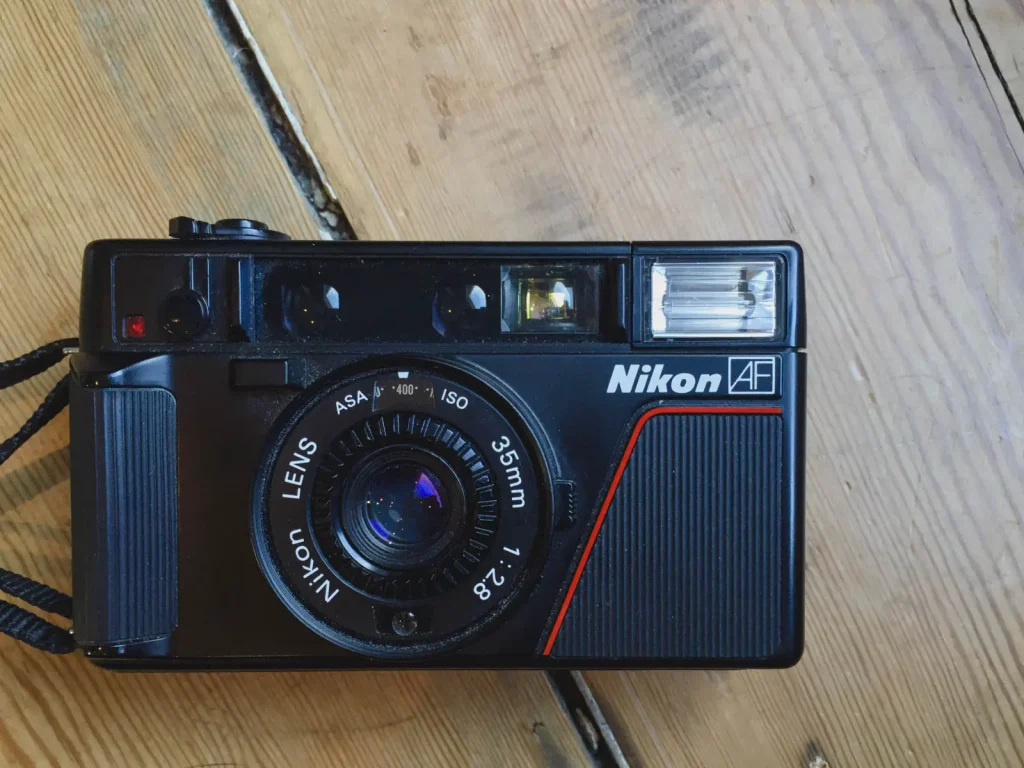
Form
Compared to the AF3, the Nikon L35af is actually a bit smaller. Certainly not as wide. I’d love to show a comparison photo but I gave the AF3 to someone for Christmas. Of course, saying it’s smaller than the AF3 doesn’t really make it small. A rhino is smaller than an elephant, but it’d be daft to say a rhino is a small animal. In the world of compact cameras, this thing is definitely the rhino.
It does has a fair amount of 80’s charm to the design. though. It is perhaps a little more conservative than the Ricoh ff90 for example – though I guess it wasn’t until the post transformers late 80’s that industrial design got quite as hard and as angular. Of course, like many 80’s cameras it has the standard flash of red that made everything in the 1980’s look cool. I personally really like the way it looks, to me, perhaps because of when I was born, this camera is what I think cameras should look like – a little like the Ford Escort mkiii looks like what cars should look like to me.
Handling
To hold, The Nikon L35af a heavy camera, or at least its heavier than its plastic exterior might lead you to believe. As far as I know, the plastic is just the bodywork that covers a metal chassis. Picking it up, you wouldn’t doubt this really. Other than that, it’s handling is about as good as it looks like it might be; its bit like holding small brick with a hand grip on one side. That being said, despite its brick like shape, it’s slightly larger size means it’s not too uncomfortable to use. Especially since the few buttons and switches it has come to the fingers nicely.
Possibly my biggest complaint – and I admit this might be a little derived from the intermittent fault giving me grief – but I don’t much care for long throw shutter buttons on electric cameras. The feedback the button gives doesn’t feel quite right to me – it just feels a bit too clunky for my liking.
Function
Thankfully, the camera does work just about enough of the time to use it. My patience doesn’t stretch to reviewing a camera that’s entirely broken, but I can just about cope with it being a little bit broken.
Much like the later AF3 functions are somewhat limited. There is a grand total of 5 controllable features on this camera, but just like when using the AF3, sometimes it makes you wonder just what else you could possibly need from a point & shoot.
The shutter
As mentioned the shutter button has a relatively long throw. I suspect that this is due to the fact that it has to action the metering, the autofocus and the autofocus distance readout in the viewfinder before it triggers the shutter. When it fires the shutter, being a leaf shutter it is fairly quiet, though like many shutters of its era does have a bit of a squeak to the sound. Thankfully, like a lot of the Nikon cameras that followed it, the automatic film advance doesn’t action until you release the shutter button, meaning that if you are trying to be discrete you have more of a chance. That said, even the film advance isn’t all that noisy. I’m not going to tell you it’s whisper quiet, but it’s more quiet than I remember my AF3 being.
The viewfinder
As mentioned, the viewfinder displays an autofocus distance readout. Very similar to the likes of the one in the Pentax PC35AF; the action of the shutter button moves a needle along the bottom of the viewfinder across a distance scale. Distances are indicated by four scale icons, with where the needle resting on or between them giving the idea of focused distance. It’s useful, but combined with the aforementioned long throw shutter button, it feels even more clunky and antiquated to me. I had the exact same complaint about the Pentax.
The viewfinder itself is fine though, mines a little on the dusty side, but actually is quite nice and bright otherwise.
The self timer
The self timer switch is top left of the front of the camera when looking at it. Switch it, press the button, wait a few seconds and it takes the photo… It’s a self timer, what more can you need from such a thing?
Backlight compensation
Backlight compensation is actioned by a small lever that rotates around the left of the lens as you hold the camera to your eye. It is there to be switched when you are shooting a backlit subject; push it, and it boosts the exposure to compensate for the backlight.
Manual ISO
DX coding on films was also introduced in the year I was born. The Nikon L35, DX Codes, Microsoft Word and me… Clearly not the best of years… Anyway, fortunately (since I’m not a fan) DX coding didn’t make it into the Nikon L35. Instead, the ISO is set via a ring that rotates around the inner part of the lens. It maxes out at 1000iso on my camera, though early models maxed out at 400iso
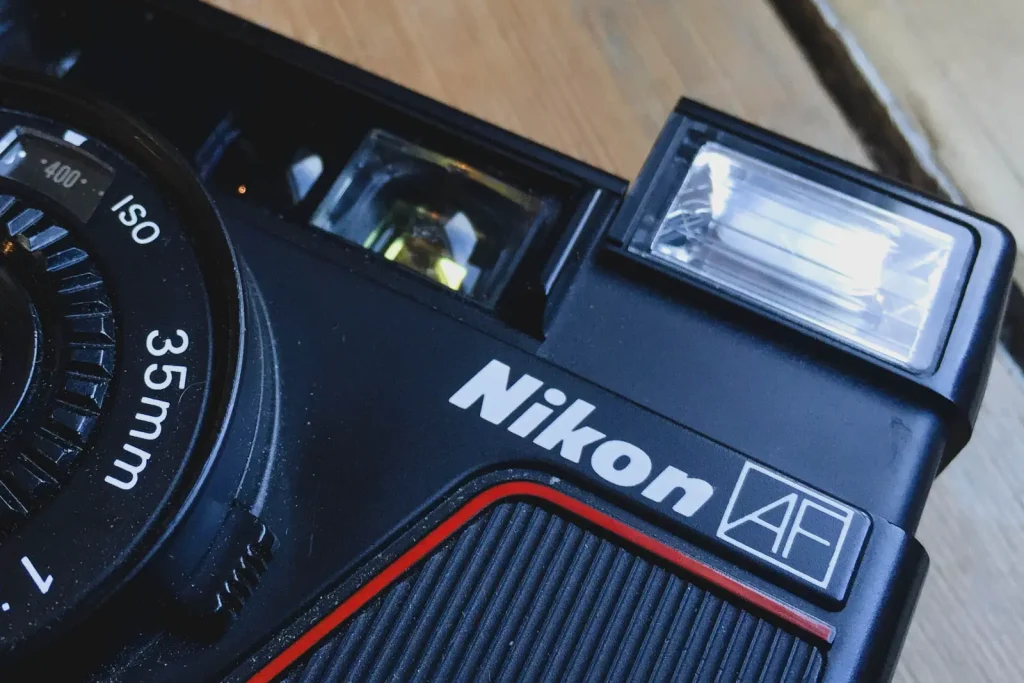
The flash
The flash is switched on automatically, and somewhat enthusiastically any time the camera perceives the light to be too low. There is no switch to turn it off, the manual flash override is just that, manual. When the light is to low the flash pops up, to stop it firing you just push it back down and hold it down. If you are predicting it will pop up, you can just hold it down to stop it and shoot away. Of all the auto flash mode compacts, as I’ve said before on this blog, this method of manual override makes the most amount of sense to me. No faffing around with menus or piddly little buttons, no red eye reduction or “night scene” flash mode nonsense. Just auto flash or forced off flash.
And that’s your lot for functions, simple but effective, as long as you are looking for a basic point & shoot, as I said, shooting with a camera like this makes you wonder what else you could possibly need. Of course, short of a camera that actually works, there is one more thing you need…
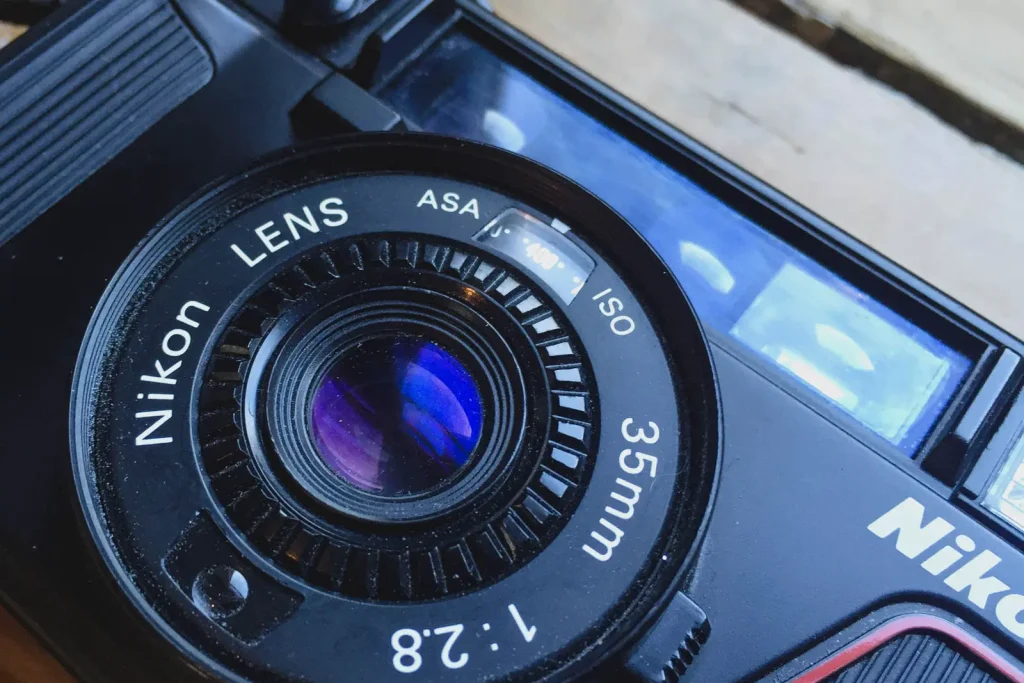
An Awesome (characterful) Lens
If you’re still scratching your head as to why a camera like this could possibly be worth spending £40-£70 on, then it’s this part of the post that might help you to understand.
The lens of this camera seems to be hailed as a bit of a classic. It’s apparently a Sonnar type lens design and exhibits character traits accordingly (at least that’s what this chap on the Nikon website says).
Unlike one of its obvious alternatives as a point & shoot, the Olympus mju-ii, which is almost clinical, the Nikon is without any doubt a lens with character. Most notably is it’s vignette. The corner/edge darkening this camera exhibits is far from a subtle character trait.
In fact, going through the 20 or so acceptable photos I’ve had out of it, not a single one doesn’t display a quite profound darkening of the corners and edges. Of course for some, this might well be a deal breaker, for my tastes though, especially with black and white I really quite like this sort of character… Especially when the lens also exhibits a lot of other positive character traits.
Along side the vignette, the Nikon L35af’s Sonnar lens is also very contrasty, and is capable plenty of resolution. Not only that, but it doesn’t seem to lose too much of this resolution into the corners. When combined with a film like XP2, the result of this is really punchy photos.
Not that I shot many photos where bokeh was a feature, but it loos pretty good in the above photo. The below photo shows a interesting propensity to a not unpleasant type flare given the the right circumstances too.
All this adds up to a very interesting lens for me. Especially the high contrast and vignette. It is those character traits that have appealed to me in many a compact camera!
A confused conclusion
As I’ve been writing this post I keep coming back to this question of “whats the big attraction?”. I think this comes from my slight confusion at the huge gap between what these cameras go for and what some very similar alternatives go for. Of course, there are cameras out there that have a second hand value that is hugely disproportionate to the type of camera they are. The Yashica T4 is a very good example. Though at least the answer to that question is relatively easy to explain. It’s Zeiss lens and moreover its celebrity endorsement make sense of the high value; even if you don’t think they are sensible justifications, they do at least remain justifications by the standards of some. The mju-ii, is another compact that demands good money, but its more modern build, tiny size and superb lens also make its value relatively easy to comprehend.
With the Nikon L35af, the attraction seems a little less obvious to me. Yes it is a camera with a wonderfully simple level of function that does indeed make you wonder what else you could need from a point & shoot. Its classic 80’s design is pretty cool and it has the provenance of being Nikons first AF point & shoot. But, perhaps above all of this, the lens is lovely – that is of course if you appreciate the look of the photos in the way I do…?
The problem is – and what sits at the core of my lack of enthusiasm – is that all this is wrapped up in a package that at 33 years old, is not getting and yet despite this, it’s also not getting any cheaper. Now of course, I’d probably not have even thought about its age if mine had been working fine, so for the sake of this review and the Nikon L35af it’s been quite unfortunate that the one I have is failing.
It’s also unfortunate that the previous post I wrote was one that contained thoughts about the potential longevity of a thread mount Leica vs. this sort of camera. These two things have born in me a concern for those looking to spend their hard earned cash on this camera and really made me question the sense in it as a purchase. Perhaps if they went for closer to Nikon AF3 prices at maybe £10-£15 I could better understand, but I’ve seen them go for £60-£70! That just seems a bit much to me for what – even when working properly – still basically amounts to an ageing, fairly clunky feeling camera with a nice lens on the front.
All of this has resulted I me writing a review that when I read it back to myself feels pretty vague. I really like the lens, but it feels like it comes at too high a cost. I like the level function, but it doesn’t feel that nice to use to me. I don’t mind that it’s old, but my experience has left me lacking trust in the things. I’ve wanted to like this camera, but every time I pick it up its annoyed me. I’ve tried to write around the fault, but it’s been hard to get enthused when it’s so often got in the way of my personal enjoyment… and when I’ve thought about just buying another working one to write about, I’ve just not been able to swallow the idea of the expense.
And that really is as best as I can sum up. For everything I like about it I find something that niggles in contradiction to that like, which in the end has just left me with a feeling of vague dissatisfaction with it. I can see why many people do like it, especially looking a the photos, but for the sort of cash they now seem to go for, I think I’d pass…
A life after death
Of course, I didn’t pass, and I was unlucky enough to end up with a duff camera. So the question is what to do with it now…? Well, now I have finished this review, and at least finished the single roll that I shot, there does remain the one thing that did get me quite excited about the camera, and thats the lens! I managed to force just a single roll through it before its ill health and slight clunkiness made me never want to shoot with it again. But getting back the photos really made me wish the rest of the experience hadn’t been so tainted. Of course, if you follow this blog chronologically you will know that my appreciation for the results from this camera, and that fact that it’s dying a slow and frustrating death, are pieces of a puzzle that fell together quite nicely.
Just before Christmas I decided I wanted a “pancake” 35mm for my thread mount Leica. I came to the conclusion that I was going use the lens from an old point & shoot. The story started here when I sent my Ricoh ff90 to JCH. At the time, perhaps because of the frustrations I was having with the Nikon and the fact that I hadn’t seen any results meant that it hadn’t even occurred to me as an option. That was until Mr. ‘Filmosaur’, or Andrej as I know him, commented talking about his experience of modding a Nikon L35af lens. I put his comment to the back of my mind until Bellamy from JCH got in touch to say the Ricoh was a no go for conversion. Straight away the dying Nikon became the obvious option for me.
It does make me wonder if this sort of modification and hacking of older cameras is only going to get more popular as more and more older cameras die out taking their wonderful lenses with them…? Time will tell I suppose, but for now I am eagerly anticipating shooting this wonderful lens on the front of a camera that doesn’t make me go “meh”…
Cheers for reading,
Hamish
Share this post:

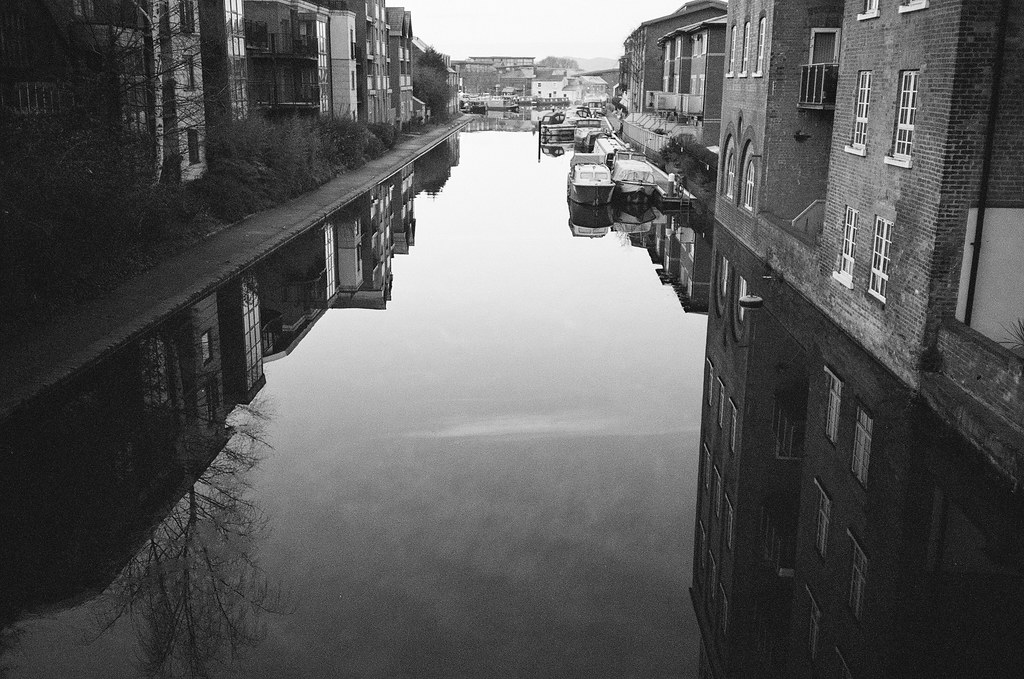
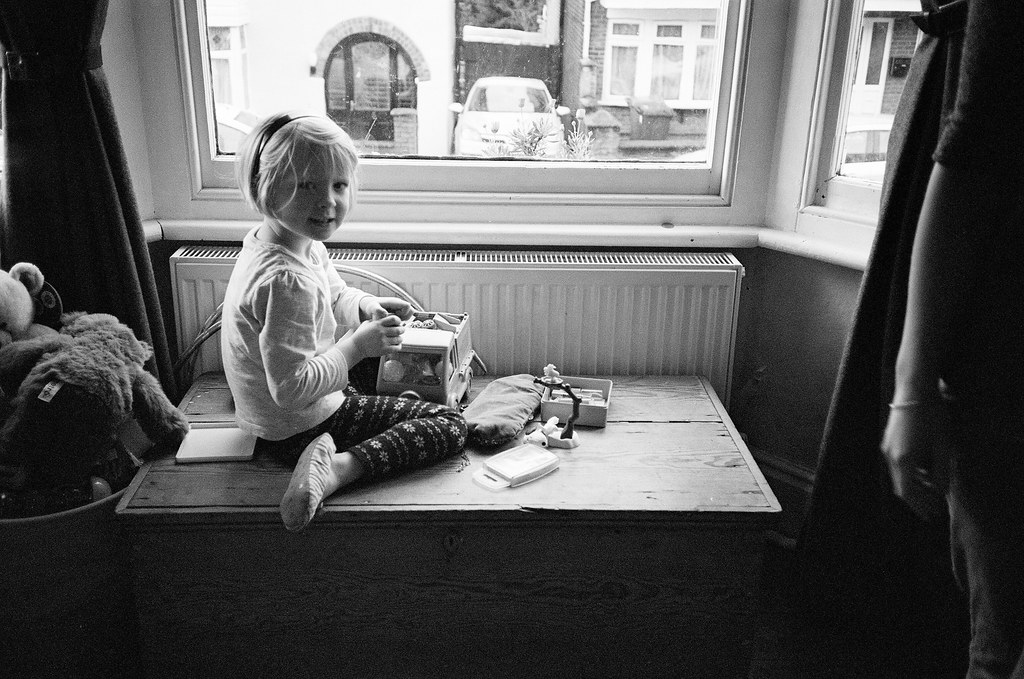
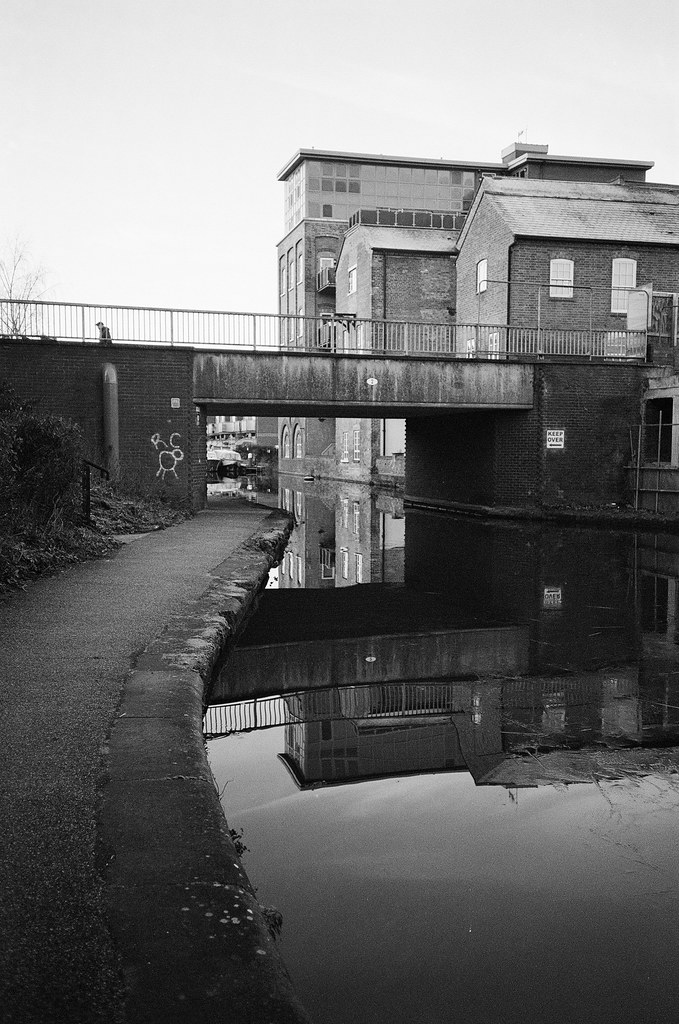
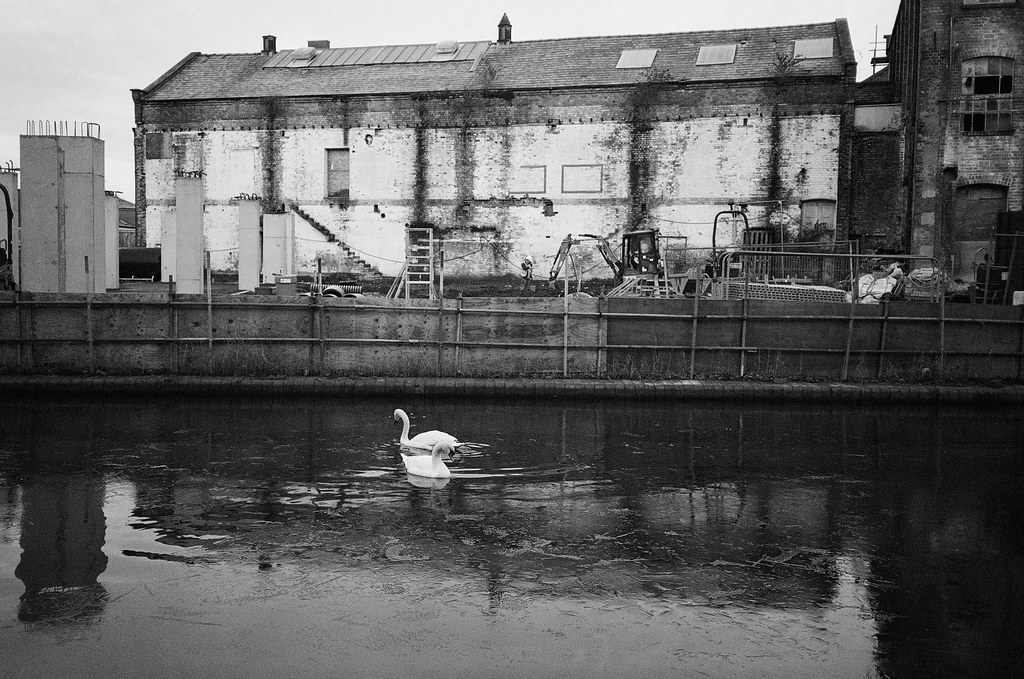
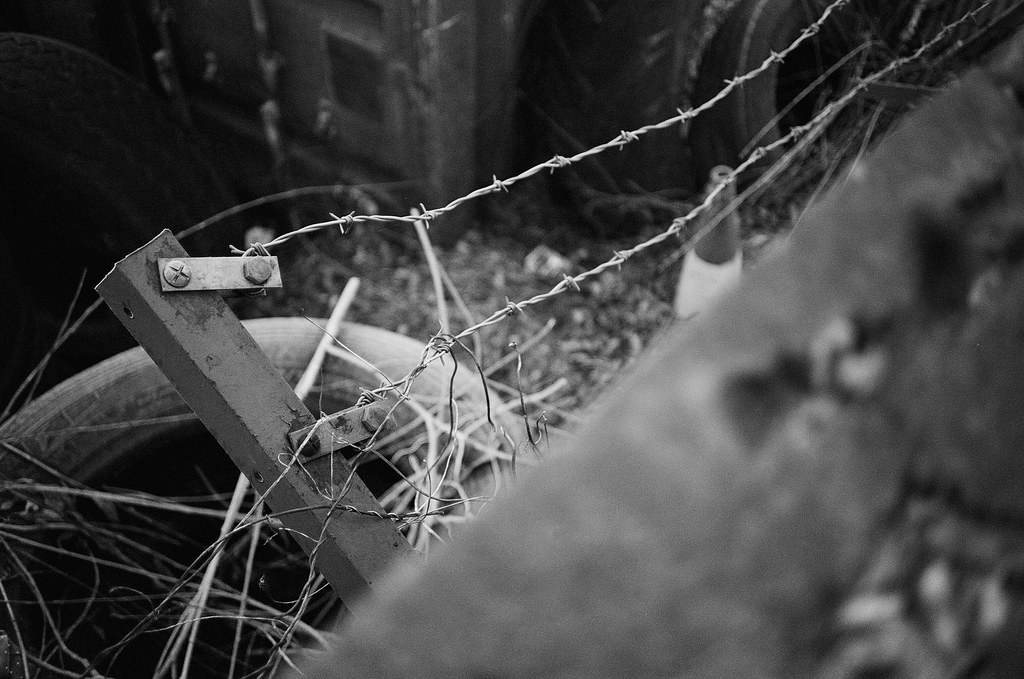
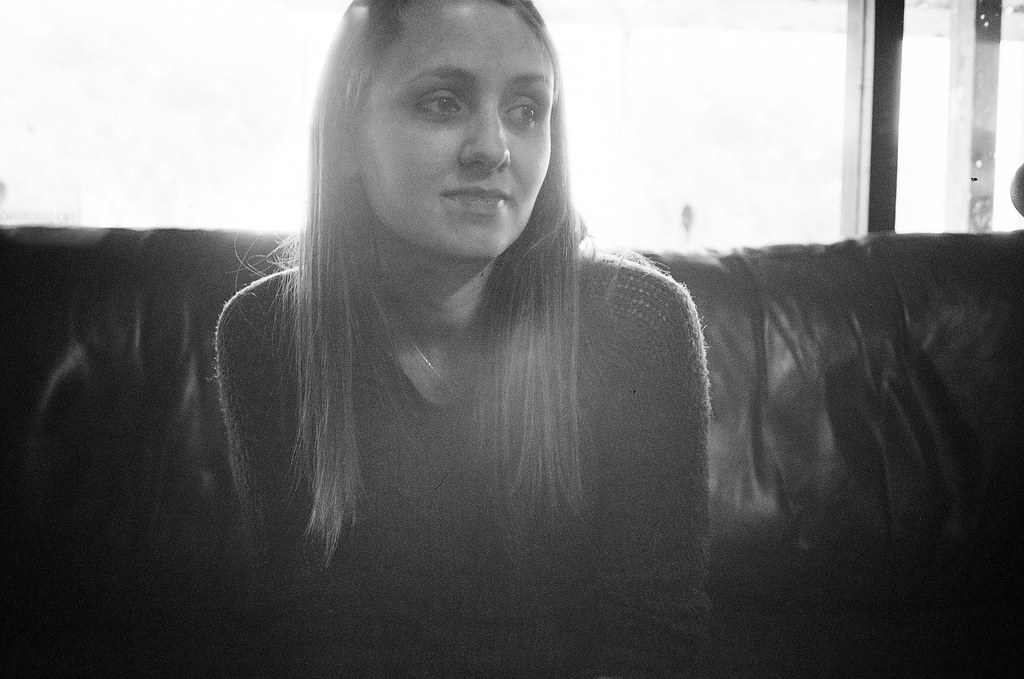








Comments
Charles on Nikon L35AF – A review of a broken camera (that will see life after it’s death)
Comment posted: 03/02/2016
Comment posted: 03/02/2016
Charles on Nikon L35AF – A review of a broken camera (that will see life after it’s death)
Comment posted: 04/02/2016
Comment posted: 04/02/2016
Eddy on Nikon L35AF – A review of a broken camera (that will see life after it’s death)
Comment posted: 04/02/2016
Comment posted: 04/02/2016
Stu Williams on Nikon L35AF – A review of a broken camera (that will see life after it’s death)
Comment posted: 05/02/2016
At least it looks good on the shelf.
Comment posted: 05/02/2016
Comment posted: 05/02/2016
Comment posted: 05/02/2016
Comment posted: 05/02/2016
Comment posted: 05/02/2016
Comment posted: 05/02/2016
Comment posted: 05/02/2016
Comment posted: 05/02/2016
Comment posted: 05/02/2016
Eddy on Nikon L35AF – A review of a broken camera (that will see life after it’s death)
Comment posted: 05/02/2016
Comment posted: 05/02/2016
Charles on Nikon L35AF – A review of a broken camera (that will see life after it’s death)
Comment posted: 05/02/2016
Comment posted: 05/02/2016
Christos Theofilogiannakos on Nikon L35AF – A review of a broken camera (that will see life after it’s death)
Comment posted: 08/02/2016
Comment posted: 08/02/2016
Ken Hindle-May on Nikon L35AF – A review of a broken camera (that will see life after it’s death)
Comment posted: 07/03/2016
Comment posted: 07/03/2016
Comment posted: 07/03/2016
Comment posted: 07/03/2016
dreadybarber on Nikon L35AF – A review of a broken camera (that will see life after it’s death)
Comment posted: 03/03/2017
Comment posted: 03/03/2017
Bill on Nikon L35AF – A review of a broken camera (that will see life after it’s death)
Comment posted: 23/06/2017
Lee Stirling on Nikon L35AF – A review of a broken camera (that will see life after it’s death)
Comment posted: 05/12/2018